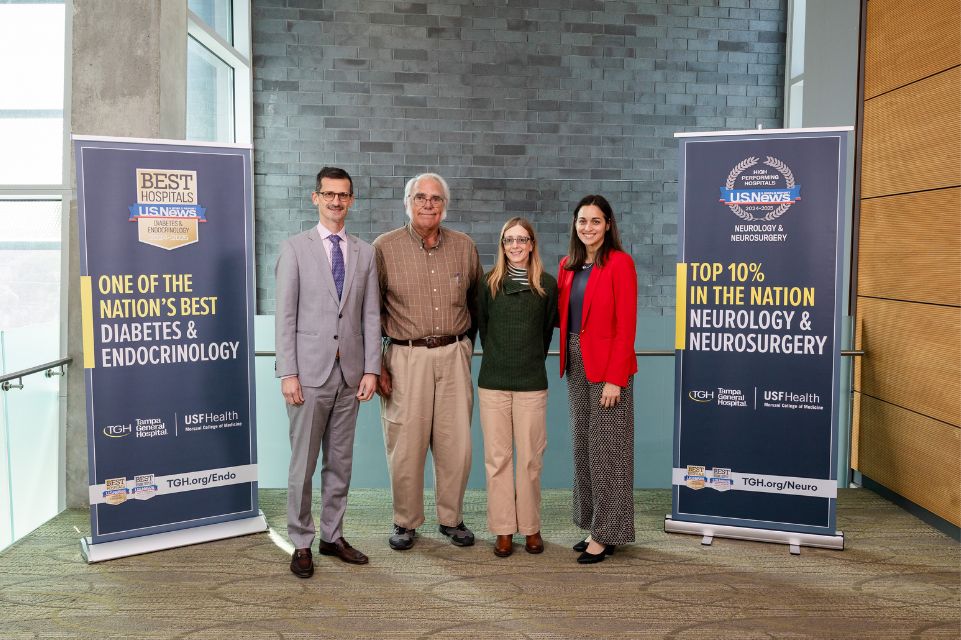Mystery Symptoms: How TGH’s Pituitary Team Decoded a Cushing’s Disease Diagnosis
Published: Oct 28, 2025
USF College of Nursing graduate Heather’s health care journey started in 2019 with several seemingly unrelated symptoms: high blood pressure, weakness, skin petechiae (spots), skinny arms and legs with an oversized torso, as well as random, unexplained bruising. She knew something was wrong, but her search for answers would take more than a few winding turns.
Heather, a University of South Florida College of Nursing graduate, endured a year of medical visits, tests, countless vials of blood draws and few answers. Doctors and specialists at other hospitals thought she may have multiple sclerosis, fibromyalgia, anxiety or a lack of muscle, but they never considered endocrine issues, even when pointing out lumps around her collarbone.
Advocating for Her Health
But Heather knew something more unusual was happening. “I wound up in the ER with a blood pressure of 210/110 mmHg. This was not normal for an active, yoga-practicing vegetarian who was an otherwise healthy 40-year-old person.” Visits with a cardiologist and nephrologist still did not reveal answers.
Heather was her own best advocate in seeking the answers she needed, recalling a crucial clue from her past.
A few years earlier, Heather was pursuing her degree at the USF College of Nursing. As part of a lesson on Cushing’s disease, her professor drew a cartoon of “Cushy the Cat” as a mnemonic to help students learn the condition.
“I don’t think I could have made it through this journey if my professor hadn’t shown us Cushy Cat and other endocrine issue animals, which helped us remember the conditions so well,” Heather said.
Cushy was sporting a blood pressure cuff, with skinny arms and legs and an outsized stomach, with bruising on the skin. Recalling the image, something clicked.
Pinpointing the Pituitary Gland
Between her endocrinology professor who introduced her to “Cushy the Cat,” and a “detective” physician in Sarasota, she finally found answers. Indeed, a biochemical workup and additional imaging tests revealed hypercortisolism — an excess of cortisol in the body — and a small tumor on her pituitary gland.
But her journey was far from over. Heather’s pituitary tumor was smaller than the recommended standards for surgery. Due to the complexity of her condition, her local physician recommended Tampa General Hospital (TGH) and the USF Health Morsani College of Medicine. Realizing her experience with the USF College of Nursing was the start of her finding answers, Heather was eager to be with the doctors and nurses from this team.
“I knew they had really high standards and were capable of great empathy and outcomes for patients,” she said.
Enter the multidisciplinary team from the USF/TGH Pituitary Program.
“The challenge in treating Cushing's disease is that even a tiny tumor can cause severe symptoms,” said Dr. Siviero Agazzi, lead pituitary neurosurgeon at TGH, professor at the USF Health Morsani College of Medicine and vice chairman of neurosurgery, director for the division of Cranial Surgery and program director of the Skull Base and Cerebrovascular Fellowship. “Finding and removing the tumor while preserving the gland function can be very challenging. Thankfully, advanced technologies in endoscopic skull base surgery and in radiosurgery allow us to successfully cure most patients.”
“Cushing’s disease is a challenging condition, as excess cortisol affects nearly every system in the body,” said Dr. Marla Sevilla-Alsina, medical director of the Pituitary Program at TGH and USF Health, and associate professor in the USF Health Morsani College of Medicine. “Although the road to recovery can be difficult, with expert care, modern surgical techniques and medical therapy or radiation when needed, many patients can regain their health and quality of life.”
After reviewing her history and running more tests, the diagnosis of ACTH-dependent Cushing's disease with pituitary origin was confirmed. Heather needed surgery to remove the small but problematic pituitary tumor behind the multiple symptoms that was affecting her daily life. This team possessed the skill to perform the delicate surgery and the expertise in long-term follow-up and management to help Heather adhere to the proper medication protocol and improve her quality of life.
Fifteen months from her first ER visit, Heather finally found answers and the treatment she needed. Three weeks after the pituitary surgery, she stopped her blood pressure medications as her cortisol levels stabilized with monitored replacement therapy. After two months, she was walking up and down the stairs with confidence. Within six months, Heather lost 25 pounds as the swelling decreased, and her neuropathy cleared. Within a year, she was back to doing handstands in her yoga practice.
Heather shared her journey at TGH and USF Health’s pituitary symposium in March 2025. For others going through difficult medical mysteries, she has a recommendation: “Flip a switch and pretend you are your own nurse and do for yourself what you would do for your patient.”
She also expressed gratitude for those who finally helped her find answers and healing.
“I am so appreciative of the nurses and doctors who really care. They took the time and effort to give their full attention and really think beyond the surface and figure out the complexities of my condition and the treatment that would help.”
